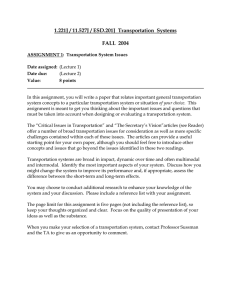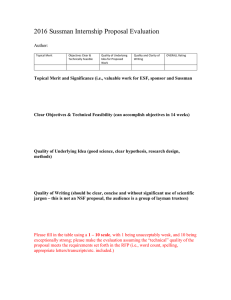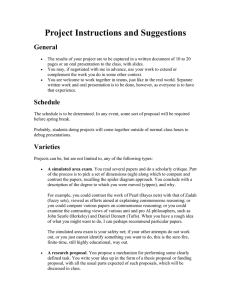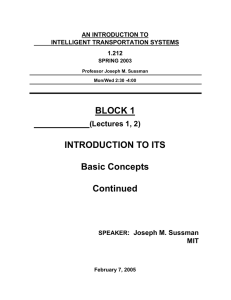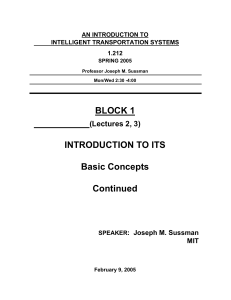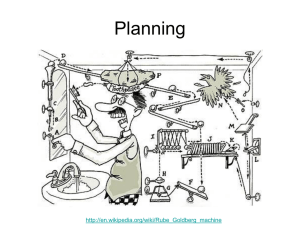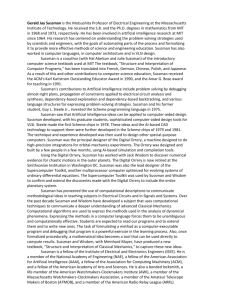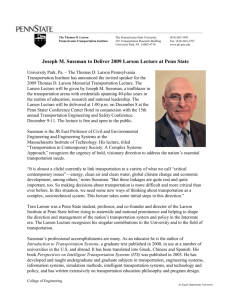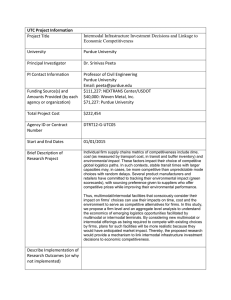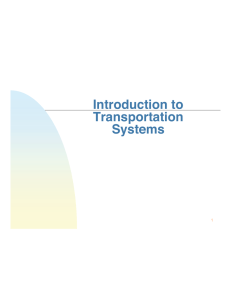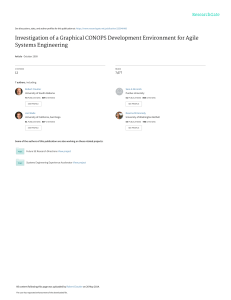LECTURE 21 REGIONAL OPERATIONS PLANNING AND ARCHITECTURE (ROPA) : Joseph M. Sussman
advertisement
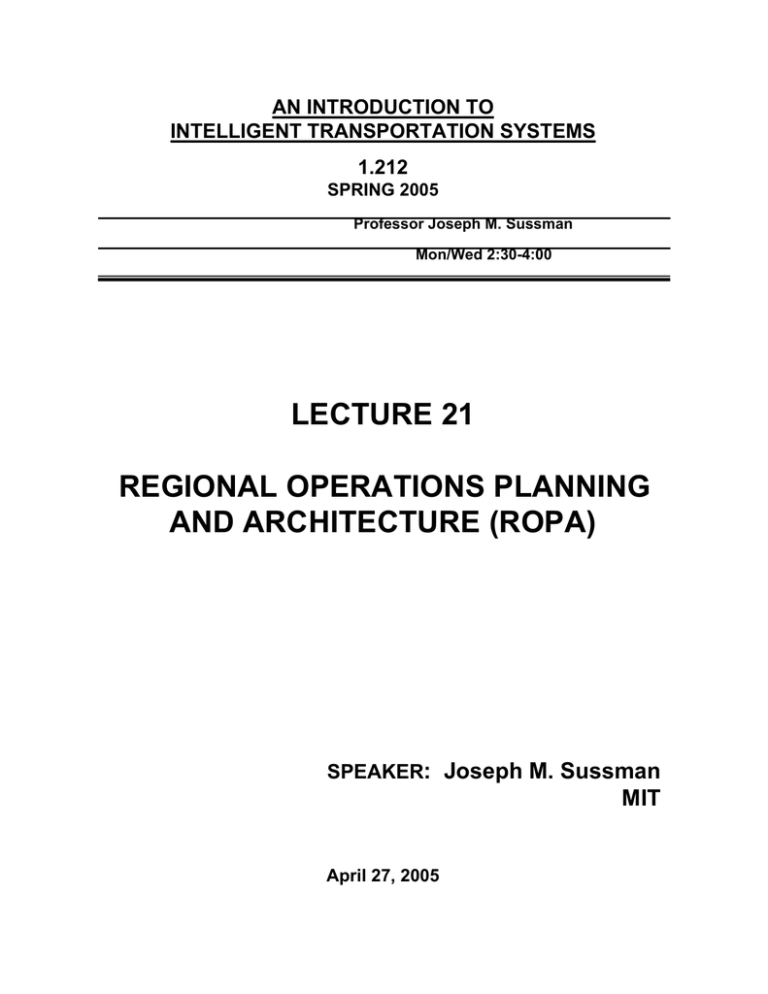
AN INTRODUCTION TO INTELLIGENT TRANSPORTATION SYSTEMS 1.212 SPRING 2005 Professor Joseph M. Sussman Mon/Wed 2:30-4:00 LECTURE 21 REGIONAL OPERATIONS PLANNING AND ARCHITECTURE (ROPA) SPEAKER: Joseph M. Sussman MIT April 27, 2005 ITS Regional Architecture There are technological aspects The Sausage Diagram There are organizational architectures as well. Composed of: Organizations (formal and informal) Flows among organizations of Roles Responsibilities Information Control (e.g. Hierarchy) Resourses “Code” Laws Regulations Norms of Behavior REGIONAL ARCHITECTURE An institutional analysis Stage one: Identifying the organizations Stage Two: Characterizing the organizations Geographic scale Temporal scale -- planning, horizon Accountability structure Management philosophy Land use Operations Infrastructure Stage Three: Characterizing the linkages Hierarchy Information flows Stage Four: Prescribing new institutional needs based on goals and objectives -- Sussman “Regional Concepts of Operations for Transportation System Management and Operations”, [Craig Roberts], February 2003. A KEY DIFFERENCE Transportation Planning vs. Planning for Operations -- [Roberts] vs. Operations [Sussman] Transportation Planning Regional Planning Architecture “Lines on Maps”, etc. Regional Operations Architecture Planning for Operations Operations ConOps can address Incident management Emergency management ATIS Weather issues Special events Electronic payment system Tolls Transit fares Parking Establishing Performance Measures/Performance Standards How is information Obtained Managed/Processed Shared Distributed -- [Roberts] REGIONAL CONOPS CONTENTS Description of existing operations Scope: geographic, linked systems, time period, players Set of expectations: the “heart” of ConOps -- goals, objectives Description of new system operations Scenarios Resources -- [Roberts] Originally presented at: National Summit on Transportation Operations Columbia, Maryland October 17, 2001 TRANSPORTATION OPERATIONS: AN ORGANIZATIONAL AND INSTITUTIONAL PERSPECTIVE Joseph M. Sussman JR East Professor Professor of Civil & Environmental Engineering and Engineering Systems Massachusetts Institute of Technology Transportation Operations: An Organizational and Institutional Perspective CUSTOMER F OCUS C ONSTRAINTS ON BUILDING CONVENTIONAL INFRASTRUCTURE O PERATIONS F OCUS TECHNOLOGY N EED FOR O RGANIZATIONAL CHANGE * FUNDING CHANGES ( PRIVATE-SECTOR, FEDERAL, STATE, LOCAL GOVERNMENT) I NSTITUTIONAL CHANGE I NFORMATION S HARING AND R ESPONSIBILITY S HARING AMONG A UTONOMOUS O RGANIZATIONS R EGIONAL S CALE OF O PERATIONS * E . G., HUMAN RESOURCE D EVELOPMENT, R EWARD AND INCENTIVE S TRUCTURE FOR O PERATIONS-O RIENTED PROFESSIONALS Transportation Operations: An Organizational and Institutional Perspective A Key Motivator: TEA-21 Reauthorization Transportation Operations: An Organizational and Institutional Perspective Why Institutional Issues Arise • • • • • • • Concern with autonomy Mission mismatch Differences in resources Funding sources Ideology Technology Information Transportation Operations: An Organizational and Institutional Perspective What We Need to Be Successful in an Operations Mission Operations needs to be 3F/3I/3R. • FUNDED: First and fundamentally, of vital importance is continuing reliable financial support for operations. • FLEXIBLE: Operations are different every day. We need organizations that can respond flexibly to the many, diverse issues that arise. Operations planning is the way this flexibility is achieved. • FOCUSED: Discipline and focus is the required organization ethos for operations. This is a part of the 24/7 operations mindset. Transportation Operations: An Organizational and Institutional Perspective • INTEGRATED: An integrated organizational response is required to deal with operations in complex, geographically-diffuse transportation networks. • INTERMODAL: Operations should be based on an intermodal concept. Our traveler and freight customers often view our services as intermodal, so we need to deal with transportation operations on this basis as well. • INFORMATION- AND CUSTOMER-BASED: New technology has put into our hands the ability to collect, process and disseminate information to our customers and to the partner agencies concerned with operating the transportation network. Transportation Operations: An Organizational and Institutional Perspective • REGIONAL: Operations need to be conducted at a regional scale, preferably using a regionallyscaled platform to support technical systems. • REAL-TIME: Operating situations are ongoing, dynamic and driven by random factors. Real-time is the temporal scale on which operating organizations need to respond. • ROUTINE: While individual stresses on the operating environment cannot be predicted, we can plan for generic kinds of service interruptions and treat them in a routine and decisive manner. Transportation Operations: An Organizational and Institutional Perspective Infrastructure Building, Preservation and Maintenance Operations Performance Transportation Operations: An Organizational and Institutional Perspective Focus Change • • • • The systems approach Accountability Incentives Leadership Transportation Operations: An Organizational and Institutional Perspective Agenda • • • Professional Capacity Building Internal Changes to Transportation Organizations Institutional Change Transportation Operations: An Organizational and Institutional Perspective We call for a fundamental rethinking of our transportation organizations for the future -at all levels of government and including the private sector -- asking them to participate in regionally-scaled transportation operations, utilizing new kinds of publicpublic and public-private partnerships and funding structures to create intermodal services for travelers and freight. This is no small thing to accomplish. Facilitating that kind of change through education and through strong and visionary leadership is central to the future success of the transportation field.
